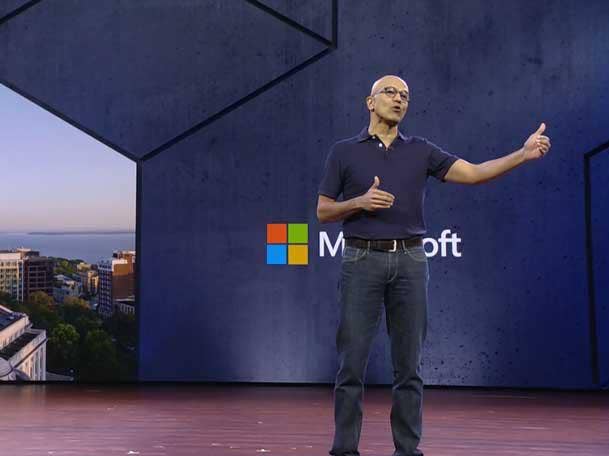Microsoft CEO Nadella Suggests Some Customers Favor Azure Because Of Amazon's Push Into New Industries

While touting a string of recent major customer wins for the Azure cloud platform, Microsoft CEO Satya Nadella on Wednesday hinted that Amazon's push into new industries such as groceries and health care could be leading some customers to choose Azure over Amazon Web Services.
Recent Azure wins cited by Nadella include a three-year deal with grocer Albertsons, announced last week, and a five-year deal with retailer the Gap, announced in November. In recent months, customers including Walmart and Walgreens have also signed deals for Microsoft cloud offerings including Azure and Office 365.
[Related: Microsoft Channel Chief Schuster On Why Multi-Cloud Partners Are 'Doubling Down' On Azure]
Speaking during Microsoft's quarterly earnings call with analysts Wednesday, Nadella was asked by J.P. Morgan analyst Mark Murphy whether Microsoft customer wins such as Albertsons and Walgreens are related to Amazon's moves into new territory.
"It's clear that [Microsoft has] fantastic alignment of our business model with the interests of our customers. In other words, we want to make sure we are, in fact, making our customers fully capable digital companies in their own right—whether they're in retail, whether they're in oil and gas, whether they're in health care. Because that's really what's in our long-term interest," Nadella said.
"And, of course, that means we have a trusted relationship, which is a competitive advantage," Nadella said. "In a world where some of our competitors have more complex business models—where in some cases they give their platforms [to customers] and other cases where they compete with them or tax them—that's definitely something that I'm sure our customers pay attention to."
Nadella didn't mention Amazon by name. Amazon has expanded its business into new verticals in recent years including groceries, with the acquisition of Whole Foods, and health care, with acquisitions such as prescription delivery service PillPack. Meanwhile, Amazon Web Services is the market-share leader in public cloud infrastructure and the only larger public cloud than Azure.
For Microsoft's second quarter of fiscal 2019, ended Dec. 31, intelligent cloud revenue jumped 20.4 percent to $9.38 billion, up from $7.79 billion the year before. The growth was fueled by a 76-percent spike in Azure revenue, while enterprise services rose 6 percent.
Microsoft's Cloud Solution Provider (CSP) program—which partners use to provide Azure and Office 365 to customers on a subscription basis—has been a key to the growth, Microsoft executives have said.
"Our CSP business has been growing very rapidly," said Ric Opal, principal at Oak Brook, Ill.-based SWC Technology Partners, a BDO USA LLP company. "I don't think we're an anomaly. I think customers are ready, and I think Microsoft has done a good job of making sure CSP is an acceptable transaction model. We're seeing great success in our CSP growth in Azure, as well as in the 'modern workplace' area."
During the quarterly call, Nadella also highlighted Microsoft's co-selling program, which gives special incentives to the company's salespeople to work more closely with solution providers. Introduced 18 months ago, the co-selling program has generated $8 billion in contracted partner revenue, Nadella said.
During the fiscal second quarter, Microsoft's productivity and business processes segment hit $10.1 billion, climbing 12.8 percent from $8.95 billion year-over-year.
Dynamics 365, the combination cloud CRP and ERM system, surged 51 percent, while Office 365 commercial revenue was up 34 percent. LinkedIn revenue rose 29 percent.
Ned Bellavance, director of cloud solutions at Blue Bell, Pa.-based Anexinet, said in an email to CRN that Microsoft's cloud offerings are driving strong demand among customers. "There are still a lot of companies that are looking to migrate to Office 365, especially with the launch of Teams," he said.
"I've also seen a sharp uptick in companies making the move to public cloud," Bellavance said. "It isn't just SMBs or enterprise accounts either. Companies of all sizes are taking a closer look and finding the public cloud and Azure, in particular, has all the necessary features and functionality they are looking for."
Microsoft's personal computing segment saw more modest growth of 6.7 percent, reaching $12.99 billion in revenue, compared to $12.17 billion during the same period a year earlier.
The segment was hampered by a 5-percent decline in Windows OEM revenue—which Microsoft CFO Amy Hood attributed to CPU supply constraints. Intel's CPU shortage has been impacting PC shipments since at least September. The shortage "constrained an otherwise healthy PC ecosystem," Hood said during the quarterly call Wednesday.
However, sales of Surface devices jumped 39 percent during Microsoft's fiscal Q2, while gaming revenue rose 8 percent.
Opal said his firm is seeing "outstanding adoption" of Microsoft's Windows Defender Advanced Threat Protection, which brings threat and exploit protection along with endpoint detection and response directly into the operating system.
"Nobody has a solution like they have when it comes to holistic security from the desktop to the data center, and subsequently to the cloud. It's just second to none," Opal said.
Bellavance added that he has "heard some talk from analysts about companies re-patriating their workloads off public cloud and back into private data centers."
"That might be happening, but for every one company moving back to private cloud, there are 20 companies moving in the other direction," he said.
During Microsoft's fiscal Q2, overall revenue rose 12.3 percent to reach $32.47 billion. That's up from $28.92 billion during the same period a year earlier.
Microsoft did fall slightly short of Wall Street expectations of $32.51 billion in second-quarter revenue, leading the company's stock price to drop 3.17 percent, to $102.67, in after-hours trading on Wednesday.
Quarterly net income on a GAAP basis came in at $8.42 billion, or $1.08 per diluted share. That's compared to a net loss of $6.3 billion—or a net loss of 82 cents per diluted share—during the same quarter a year ago, which stemmed largely from a tax on repatriation of money held overseas.